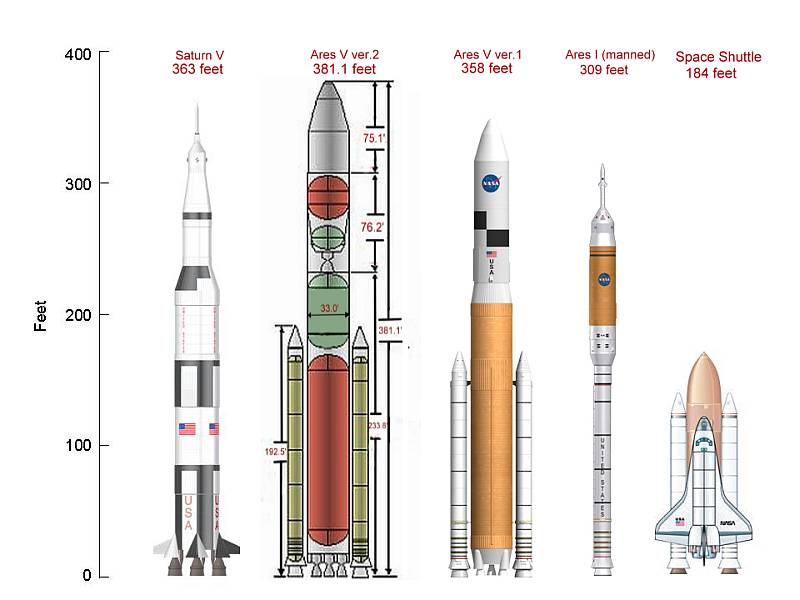Planning and early design are under way for hardware, propulsion systems and associated technologies for NASA's Ares V cargo launch vehicle -- the "heavy lifter" of America's next-generation space fleet. Ares V will serve as NASA's primary vessel for safe, reliable delivery of large-scale hardware to space -- from the lunar landing craft and materials for establishing a moon base, to food, fresh water and other staples needed to extend a human presence beyond Earth orbit.
Under the goals of NASA's exploration mission, Ares V is a vital part of the cost-effective space transportation infrastructure being developed by NASA's Constellation Program to carry human explorers back to the moon, and then onward to Mars and other destinations in the solar system.
The Ares V effort includes multiple hardware and propulsion element teams at NASA centers and contractor organizations around the nation, and is led by the Ares Projects Office at NASA's Marshall Space Flight Center in Huntsville, Ala. These teams rely on nearly a half century of NASA spaceflight experience and aerospace technology advances. Together, they are developing new vehicle hardware and flight systems and maturing technologies evolved from powerful, proven Saturn rocket and space shuttle propulsion elements and knowledge.
The versatile, heavy-lifting Ares V is a two-stage, vertically stacked launch vehicle. It can carry nearly 414,000 pounds (188 metric tons) to low-Earth orbit. When working together with the Ares I crew launch vehicle to launch payloads into Earth orbit, Ares V can send nearly 157,000 pounds (71 metric tons) to the moon.
For its initial insertion into Earth orbit, the Ares V first stage relies on two five-and-a-half-segment reusable solid rocket boosters. These are derived from the space shuttle solid rocket boosters and are similar to the single booster that serves as the first stage for the cargo vehicle's sister craft, the Ares I crew launch vehicle. This hardware commonality makes operations more cost effective by using the same manufacturing facilities for both the crew and cargo vehicles.
The twin reusable solid rocket boosters of the cargo lifter's first stage flank a single, liquid-fueled central booster element, known as the core stage. Derived from the Saturn V, the core stage tank delivers liquid oxygen and liquid hydrogen propellants to a cluster of six RS-68B rocket engines. The engines are upgraded versions of those currently used in the Delta IV, developed in the 1990s by the U.S. Air Force for its Evolved Expendable Launch Vehicle program and commercial launch applications. Together, these propulsion elements comprise the Ares V's first stage.
Atop the central booster element is an interstage cylinder, which includes booster separation motors. It connects the core stage to the Ares V Earth departure stage, which is propelled by a J-2X main engine. The J-2X, also powered by liquid oxygen and liquid hydrogen, is an evolved variation of two historic predecessors: the powerful J-2 upper-stage engine that propelled the Apollo-era Saturn IB and Saturn V rockets to the moon and the J-2S, a simplified version of the J-2 developed and tested in the early 1970s.
Anchored atop the Earth departure stage is a composite shroud protecting the Altair lunar lander, which includes the descent stage that will carry explorers to the moon's surface and the ascent stage that will return them to lunar orbit to rendezvous with the Orion crew exploration vehicle for their return home.
During launch of an Ares V, the reusable solid rocket boosters and core propulsion stage power the vehicle into low-Earth orbit. After separation from the spent core stage, the Earth departure stage's J-2X engine takes over, placing the vehicle in a circular orbit, and the departure stage shroud separates to prepare the lander for rendezvous with the Orion capsule.
Orion carrying four astronauts is delivered to space separately by the Ares I rocket. Orion then docks with the orbiting departure stage and its lunar lander payload. Once mated, the Earth departure stage fires its J-2X engine a second time to achieve "escape velocity," the speed necessary to break free of Earth's gravity, and the lunar vessel begins its journey to the moon.
The Earth departure stage is jettisoned after it puts the mated Orion capsule and Altair lander on course for the moon. Once the astronauts arrive in lunar orbit, they transfer to the lunar module and descend to the moon's surface. Orion remains in orbit until the astronauts depart from the moon in the lunar vessel, rendezvous with the spacecraft in orbit and return to Earth.
The Ares V also represents an unmatched national asset for lifting heavy exploration, scientific, and commercial payloads to Earth orbit or trans-lunar injection, a trajectory designed to intersect with the moon. Such lift capabilities will enable NASA to, in time, undertake crewed missions to destinations beyond the moon.
The first test flight of the Ares V is planned for around 2018. The first crewed lunar excursion is scheduled for launch in the 2020 timeframe.
More Information:> Naming NASA's New Rockets> Ares V Cargo Vehicle (PDF, 381 KB)> J-2X Engine (PDF, 2.7 MB)> View Expanded Views of Ares-I and Ares-V (1.3 Mb PDF)
View Video of Ares: Launching the Future
> Windows Low |
> High |
> RealPlayer Low |
> High

